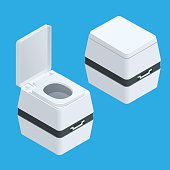
Composite toilet is a type of dry toilet using that natural processes of managed aerobic decompostion and composting to treat and recycle human excreta. When human waste enters the composite toilet, ninety percent of the water content uses a vent system for evaporating water that is carried back to the atmosphere. The small percentage for the solid material is converted to fertilizer by natural decomposition. This natural process is enhanced in commercial toilets by manipulation of the environment in the composting chamber. It is important to have a balance between the moisture, heat, oxygen and organic material for ensuring a rich environment for the aerobic bacteria, transforming wastes into fertilizing soil.
The end product of this process doesn’t contain any pathogens that are destroyed by bacterial breakdown which is a nutrient-rich fertilizer that can be used around the base of trees or plants, thus reduces need for commercial fertilizers and preserves local water quality. The three separate processes used by composting toilets involve quickly composting waste and toilet paper to remove odor, ensuring the finished compost is easy to handle and safe, and evaporation of liquid. Composite toilets use no or little water, and are often considered as good alternatives for flush toilets in situations without suitable water supply or sewer system. Gradual cold composting connected to a secondary external composting step is used by composting toilets in facilitating aerobic processing, odor mitigation and liquid absorption. There are two elements of a composting toilet which are a place for sitting and a composting or collection unit with composting or storage chamber, ventilation unit, collection system and access door.
Composite toilets have design considerations that include environmental factors, aeration and mixing, additives and bulking material and leachate management. The are four main environmental factors affecting the decomposition process including sufficient oxygen, forty to seventy percentage of moisture content, forty to fifty percentage degrees Celsius temperature and twenty-five is to one carbon-to-nitrogen ratio. It is important to add bulking materials or additives to cover feces and reduce insect access which include wood chips, saw dust, bark chips, pieces of paper or ash. It is crucial to have a leachate management system to hasten the aerobic decomposition using a urine-diverting system or urine separator, and a drainage system at the bottom of the composter. In order to pass out carbon dioxide and odors, commercial tinyhousehugeideas.com composite toilets have a ventilation system for aeration and mixing used for moving air from the bathroom through the waste container, out to a vertical pipe and vent above the roof in order to pass odors and carbon dioxide. Allow us to share some important environmental tips with your and learn more info about composting toilets, their mechanism, applications and product reviews by visiting our homepage or website.
You could also take a look at http://www.ehow.com/how_2085439_build-composting-toilet.html if you like to know more.